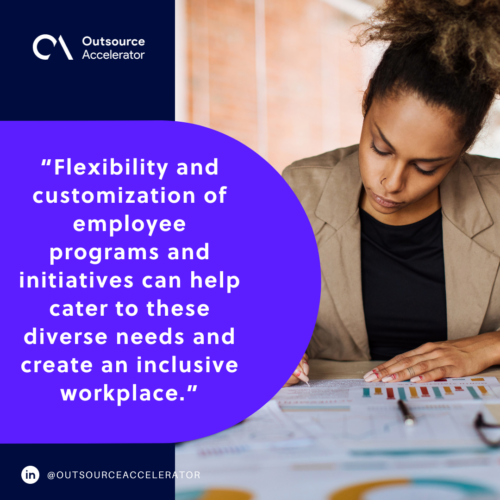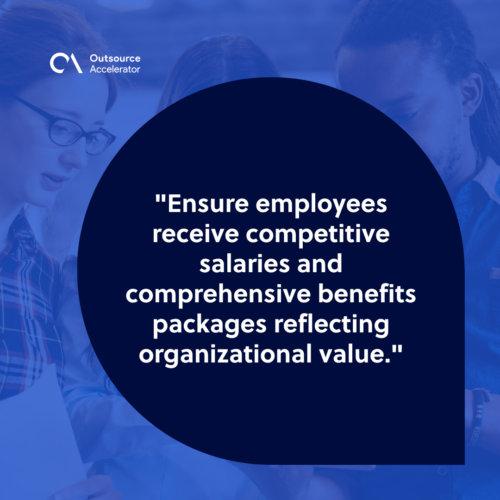10 different ways to invest in employees

Your employees are what keeps your business going, apart from customers. They are the driving force behind your operations, doing the majority of the work to achieve your company goals.
Therefore, it is necessary to invest in employees and increase their engagement. By recognizing the value and potential of your workforce, you demonstrate a commitment to their growth, development, and well-being.
Investing in employees naturally consumes time, effort, and thoughtfulness on your part. However, this is worth it when you see your teams taking care of your customers the same way you do with them.
Read about the different ways you can invest in your employees in this article.
Why is it important to invest in employees?
Investing in employees is a strategic choice to spend time and resources to keep employees informed.
This effort goes beyond offering competitive salaries and employee benefits. It can range from simple gestures such as appreciation cards to providing training sessions for upskilling and development.
Employees who feel valued and supported are more likely to be engaged, productive, and motivated to contribute to the company’s success.
A study conducted by Gallup revealed that companies with engaged workforce have higher earnings per share and lower turnover. This is compared to their competition, with lower engagement, reaching up to 43% turnover rates.

Additionally, investing in employees fosters a positive workplace culture and increases employee loyalty, reducing its associated costs. With a bad hire costing 30% of a staff’s salary, investing in your staffing can help you save up to US$240,000 in return.
Therefore, investing in employee retention can significantly impact the bottom line.
Challenges to investing in employees
While investing in employees is essential, it is not without its challenges. Various factors, such as competing priorities, can make allocating resources toward employee development difficult.
Here are some challenges you might face when investing in your employees and how you can resolve them:
Limited budget
One of the most common challenges businesses face is having a limited budget for employee investment.
Allocating resources for training programs, development initiatives, and other employee-focused initiatives can be a financial strain, especially for small businesses.
However, it is crucial to find creative ways to work within your budget and prioritize investments that will have the greatest impact.
For example, cost-effective online training platforms or internal resources for mentoring are readily available for onboarding and upskilling employees.
Popular tools such as Salesforce and Hubspot also offer free certifications for specialized training.
Time constraints
Another challenge is finding the time to invest in employees amidst the daily business demands. Managers and leaders often have limited time for employee development and may prioritize immediate tasks over long-term investments.
Investing in your employees requires better time management, delegation of tasks, and setting aside specific periods for employee-focused activities.
You can consult employees through surveys and town hall meetings on their preferred schedule for training so you can allot them beforehand.
Resistance to change
Investing in employees often involves introducing new ideas, processes, and initiatives.
However, change can be met with resistance, particularly if employees feel their existing ways of working are being challenged or disrupted.
Overcoming this challenge requires effective communication, transparency, and involvement from the employees themselves. Communicate the purpose and benefits of the changes clearly and involve employees in the decision-making process to foster a sense of ownership.
Measuring impact and ROI
It is easier to measure tangible outcomes like increased productivity or reduced turnover. However, the impact of intangible factors like improved employee engagement or enhanced teamwork can be harder to quantify.
The key to seeing this impact is to track and measure key metrics to assess the effectiveness of your employee investments.
You can measure this impact through employee surveys, performance evaluations, and tracking key performance indicators in their work.
Managing diverse needs
Businesses today have diverse workforces with employees from different generations, backgrounds, and experiences.
Investing in employees involves understanding and addressing their unique needs and preferences. For example, millennials and gen Zs may prioritize work-life balance and opportunities for growth, while older employees may value stability and recognition.
Flexibility and customization of employee programs and initiatives can help cater to these diverse needs and create an inclusive workplace.

Sustaining long-term commitment
Employee investment is a continuous process. A long-term commitment to employee development and support can be challenging, particularly with competing priorities and limited resources.
More so, employee demands and preferences can change as trends arise.
Making employee investment an integral part of your long-term organizational culture and values is crucial. This involves aligning leadership behaviors, performance metrics, and incentives to reinforce the importance of ongoing employee investment.
Benefits of investing in employees
Investing in employees yields numerous benefits, both tangible and intangible.
For one, providing professional growth and development opportunities can enhance employee skills and knowledge and boost their performance and productivity.
A Gallup study mentioned earlier found that organizations prioritizing employee development have 10% higher customer satisfaction ratings and 20% higher sales than those that do not.
Moreover, investing in employee well-being can lead to higher job satisfaction, lower stress levels, and improved mental and physical health. Healthy and happy employees can contribute positively to the organization.
According to RAND’s Workplace Wellness Programs study, companies with effective wellness programs experience a 25% reduction in absenteeism and a 24% decrease in healthcare costs.
These benefits can ultimately contribute to higher retention rates and a more positive employer brand. A study conducted by LinkedIn revealed that 94% of employees would stay longer at a company that invests in their career development.
Additionally, organizations with a positive employer brand attract top talent, reducing recruitment costs and generating a competitive advantage in the market.
10 ways to invest in employees
There are different ways you can apply to invest in employees. Here are some of them:
1. Provide learning and development opportunities
Offer training programs, workshops, and certifications to enhance specific skills and broaden knowledge.
Encourage employees to take ownership of their learning journey through self-paced online courses and continuous professional development.
2. Establish mentorship programs
Encourage experienced employees to mentor their colleagues, fostering a culture of continuous learning. Pairing employees with mentors can provide valuable guidance, career insights, and networking opportunities.
3. Create a positive work environment
Promote a supportive and inclusive workplace culture where employees feel valued, respected, and nurtured. Emphasize teamwork, collaboration, and open communication to foster a sense of belonging and engagement.
4. Offer flexible work arrangements
Grant employees the freedom to manage their work-life balance, such as flexitime or remote work options. Flexible arrangements empower employees to meet personal commitments while maintaining their productivity and job satisfaction.
5. Recognize and reward achievement
Implement recognition programs that celebrate outstanding performance, reinforcing a culture of appreciation and excellence. Regularly acknowledge and reward achievements to motivate employees and boost morale.
6. Offer wellness programs
Encourage employees to prioritize their well-being by offering wellness programs and promoting realistic and healthy habits. Provide resources such as gym memberships, mindfulness sessions, and flexible leave policies to support employee well-being.
7. Foster open dialogue within teams
Facilitate open dialogue and employee collaboration through regular team meetings, brainstorming sessions, and cross-functional projects.
Encourage employees to share ideas, perspectives, and knowledge for innovation and growth.
8. Provide competitive compensation and benefits
Ensure employees receive competitive salaries and comprehensive benefits packages reflecting organizational value.
Regularly review and benchmark compensation to attract and retain top talent.

9. Support career advancement
Create clear career paths, offer promotional opportunities, and provide regular feedback on employees’ progress and development. Encourage continuous learning and skill building to prepare employees for future leadership roles.
Supporting your staff’s career advancement is also a good way to practice efficient executive hiring in your organization.
10. Invest in workforce diversity and inclusion
Promote an inclusive environment that embraces diverse perspectives and backgrounds, ensuring equal opportunities for all employees.
Implement diversity training, diverse hiring practices, and employee resource groups to foster a culture of inclusion.
Long-term vs. Short-term investment in employees
When investing in employees, it is crucial to balance short- and long-term investments.
Short-term investments focus on immediate needs, such as skill development for specific projects. These investments can lead to increased productivity and short-term results.
However, organizations should not overlook the importance of long-term investments. Focus on nurturing talent for future leadership roles or developing comprehensive career growth programs.
Organizations can ensure a sustainable and effective employee investment strategy by considering short- and long-term objectives.
Remember to put the employees first
In all employee investment efforts, it is essential to prioritize the well-being and satisfaction of your workforce. A genuine commitment to employee care and development sets the foundation for a successful investment strategy.
Organizations must understand their employees’ unique needs, aspirations, and challenges. They should tailor their investment initiatives to create a workplace that fosters growth, engagement, and success for all.
Capitalizing on employees is an investment in the future of your organization. Implementing the ten strategies outlined above and prioritizing employee satisfaction and development is a great way to create an impact within your company.
This goes along with obvious benefits, from enhanced performance to increased loyalty and retention rates.
Through consistent and thoughtful investments in their workforce, organizations can create a competitive advantage and thrive in the dynamic business landscape.







 Independent
Independent




